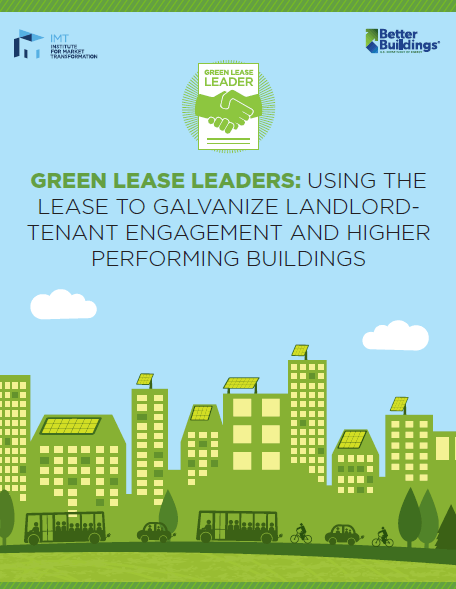With a green, high-performance lease, landlords and tenants can better work together to save billions of dollars and lock in smarter, more efficient operation of buildings. Since its inception in 2014, IMT and the U.S. Department of Energy’s (DOE) Better Buildings Alliance’ Green Lease Leaders recognition program has grown to include firms that represent more than 1.8 billion square feet of building space—a clear indication that green leasing is no longer considered an exception, rather it is becoming best practice across real estate markets.
As building efficiency efforts have progressed to more advanced and holistic approaches, green leases have evolved as well. The 2018 cohort of Green Lease Leaders are using the lease to not only overcome split incentives but also drive innovation and adoption of forward-thinking strategies that create value. In the final installment of a new three-part case study series, IMT and DOE’s Better Buildings Alliance shine a spotlight on 2018’s Green Lease Leader designees that are using strategies to increase tenant engagement that unlocks greener, higher-performing buildings and spaces that go above and beyond the critical goal of reducing energy consumption. In each case study, leading sustainability professionals share their organization’s best practices that every real estate or sustainability practitioner should consider when leasing property.
Read Green Lease Leaders: Using the Lease to Galvanize Landlord-Tenant Engagement and Higher Performing Buildings to learn about:
- Commonwealth Partners’ smart use of a sustainability calendar and environmental signage to engage tenants and build awareness, excitement, and a sense of achievement for sustainability efforts.
- Forest City Realty Trust’s leading-edge multifamily green leasing and how it trains leasing agents to help them speak about a building’s sustainability features and communicate value to prospective tenants.
- JBG SMITH Properties’ creation of a green leasing task force and leasing playbook for communicating the sustainability of the company and the benefits of renting space in high-performance building.
- Kimco Realty Corporation’s use of lease clauses that allow the company to submeter most of its tenant spaces and provide tenants with information that encourages them to pursue more efficient operations.
- Prologis’ green lease and how it strengthens business relationships with tenants and helps align sustainability and operational efficiency goals between both parties.
This resource is the final in a three-part series to showcase exciting green lease trends and stories about the Green Lease Leaders that are driving them.
- Read part one to learn how Green Lease Leaders are using the lease to drive innovation and clean energy.
- Read part two to learn how Green Lease Leaders are using the lease to incorporate health & wellness priorities to make buildings more healthy and efficient.
- Visit greenleaseleaders.com/resources for more on how Green Lease Leaders are using the lease to catalyze high performance in buildings.
Become a Green Lease Leader
If you are a tenant encouraging your landlord to collaborate on sustainability goals, or if you’re a landlord working closely with tenants to make their space more efficient and healthy, you might be a candidate for IMT and DOE’s Green Lease Leaders recognition.
A first step is to assess your lease and corporate documentation in comparison to the standards specified by the Green Lease Leaders recognition program. Even if you are not currently including energy efficiency and sustainability in your lease, but practice sustainability in building operations and management, the Green Lease Leaders criteria can serve as a guide for enhancing a lease to account for sustainability.
For more information on Green Lease Leaders, or for help in building your own green lease, visit the Green Lease Leaders website to learn more about the program and how to apply for recognition at greenleaseleaders.com/apply or contact IMT at imtweb@imt.org.
